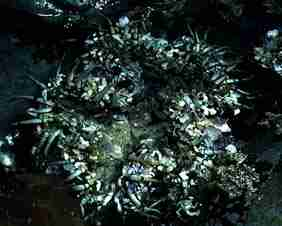|
|
Sand Anemone Oulactis muscosa
Form:
This is the large Sand Anemone is found in sand-filled cracks and crevices, with only the oral disk and tentacles visible. The spots on the column are sticky bumps or swellings called verrucae. These can stick to bits of sand and shell. There are three distinct rows of short tentacles.
Colour:
The Sand Anemone's column is coloured greenish grey to off-white, with rows of darker bumps, called verrucae. The oral disk is variable in colour, and may be red, green, black or white,with darker streaks radiating from mouth. The tentacles are pale greenish to greyish-white, marked with horizontal black bands. Because of its habit of being found in sand filled cracks it is often hard to determine the column colour.
Phylum: |
Cnidaria |
Author: |
Drayton, 1848 |
Family: |
Actiniidae |
Size: |
60-80 mm |
Distribution:
 Southern
Queensland, New South Wales, Victoria, Tasmania and South Australia, east
of Spencer Gulf. Also New Zealand.
Southern
Queensland, New South Wales, Victoria, Tasmania and South Australia, east
of Spencer Gulf. Also New Zealand.
Habitat:
The Sand Anemone is mostly found on sand covered rocky areas, usually in water filled cracks and crevices, with only the sand-covered oral disk and tentacles visible.
Biology:
The Sand Anemone is recognised by its habit of having bits of gravel, shell or coarse sand attached between its tentacles. Gravel may also be attached to the column by sticky adhesive swellings called verrucae.
It has a very close relation, the Southern Sand Anemone, Oulactis macmurrichi which lives in an identical habitat. This south-western Australian species has a more reddish-brown, or green to light purple, column with light green tentacles. Some researchers consider they are two variants of the same species.
References:
W.J. Dakin's classic study: Australian Seashores. p.175, Angus & Robertson, Sydney.
Davey, K. (1998) A Photographic Guide to Seashore Life of Australia. p.32, New Holland, Sydney.
Edgar, G.J. (1997) Australian Marine Life: the plants and animals of temperate waters. p.126, Reed Books, Kew.
Marine Research Group of Victoria (1984) Coastal Invertebrates of Victoria: an atlas of selected species. p.11, Museum of Victoria, Melbourne.
Shepherd, S.A. & Thomas, I.M. (1982) Marine Invertebrates of Victoria, Pt. 1. p.167, South Australian Government Printer, Adelaide.
Waratah
Anemone
Eastern Sand Anemone
Home
Page
Taxonomy
Biogeography
Rocky Shores
Tidal Levels
Intertidal Zonation
Environmental Factors
Biological
Factors
Feeding Relationships
Activities
Glossary
References
 Life
on Australian Seashores
Life
on Australian Seashores
by Keith Davey (C) 2000
Learning Consultant
- Media
The University of Newcastle
email at australian_seashores@hotmail.com
Scientific Consultant: Phil
Colman
site created 01.01.98 : updated 01.04.2000

